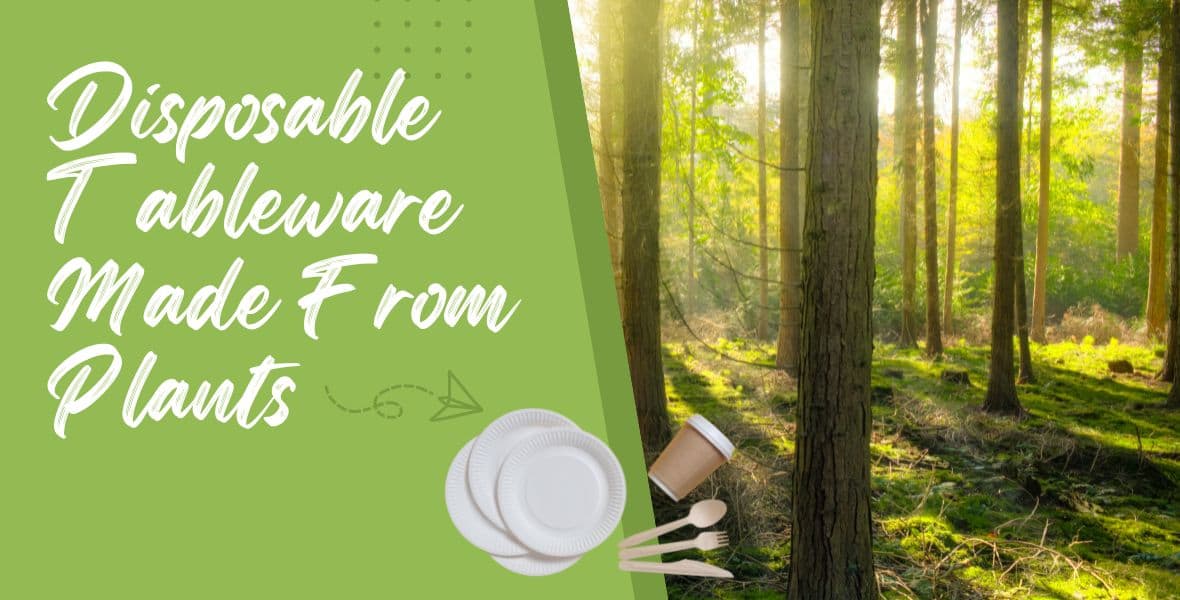A new way to manufacture disposable tableware is emerging that uses plants instead of petrochemicals and plastics. These plastics-free alternatives are known as Plant-Based Disposable Tableware. The growing demand for plant-based plastics, is pushing producers to find a cost-effective replacement solution.
Plastic has been identified as one of the top environmental threats by scientists. It remains in landfills for hundreds of years, wreaking havoc on the environment and human health with every use. To address this issue and reduce plastic waste, manufacturers are turning to alternative production methods that use fewer raw materials and produce less waste.
How is plant-based plastic made?
Plant-based polymers are derived from renewable resources like corn starch, sugarcane, or tapioca. These raw materials are then refined using ethylene, propylene glycol, or vegetable oils to create polymers that are stable for the production of plastic products. In the manufacturing process, the polymers are melted down and solidified into a polymer blend before being extruded. Plant-based plastics can be found in disposable tableware and packaging items such as bottles, cups, plates, and cutlery. These are often made from corn starch, potatoes, or algae. They can also be used in the food industry to produce things like bio-oil or alcohol, or as a coating for plant seeds.
A few manufacturing techniques to make plant-based disposable tableware
In the process of making plant-based plastics, the raw materials are converted into a liquid or a solid before processing them into a polymer blend. Next, the polymer is cooled and then fed into a die. Depending on the desired shape, the plastic is heated and blown into a mould where it is cooled and solidified. At the end of the process, the tableware item is peeled out of the mould and finished. For example, corn starch is converted into a syrup and then into a granular form, which is then dried. Next, the granules are pressed and heated with steam, which converts starch into starch sugar. Next, the sugar is heated with steam and propylene glycol, and then cooled to obtain a liquid form. The liquid is then filtered and heated with ethylene glycol to form a polymer. At the end of the process, the tableware item is peeled out of the mould and finished.
Why switch from disposables?
With growing concerns about plastic pollution and sustainability, manufacturers are turning to plant-based alternatives to replace plastic in their products. For example, a popular disposable tableware material is made from corn starch, which has a low oil content. However, when the oil-based plastic tableware is thrown away, it takes hundreds of years to decompose in landfills. Plant-based tableware manufacturers have therefore identified a cost-effective solution to reduce plastic waste – replacing plastic tableware with plant-based tableware. By doing so, the manufacturers also benefit from the sustainability benefits of plant-based alternatives, such as reduced emissions and being more environmentally friendly.
Benefits of using disposable tableware made from plants
- Sustainability – When compared to petrochemical-based plastics, plant-based tableware is more sustainable, with lower emissions and less environmental impact. For example, corn is grown using minimal intervention, which reduces the use of pesticides and other chemicals. The raw material is also relatively inexpensive, making it possible to produce high volumes of tableware at a relatively low cost. Furthermore, the starch that is produced can be used multiple times, resulting in less waste.
- Quick-to-mature crops – Among the most popular tableware items are plastic plates, straws, cups and cutlery made from corn. Corn is a quick-to-mature crop, which is one of the reasons why it is one of the most cost-effective tableware materials available. In just six months, corn can be harvested and sent to a plant supplier. This makes it possible to produce corn-based tableware in large quantities, which helps to reduce the costs of producing a single item.
- Compostable – Since corn is grown using minimal intervention, it can be easily composted. Plant-based products made using Polylactic Acid (PLA) require composting in municipal composting facilities. Not all communities have a municipal composter. Polyhydroxyalkanoates (PHA) is a plant-based resin that is both marine degradable and backyard compostable.
Conclusion
Production of disposable tableware has been facing an increasing challenge of using limited raw materials and producing high volumes of the products at a high cost. In response to this challenge, plant-based tableware manufacturers are exploring new ways of producing disposable tableware. These alternatives are often cheaper and produce less waste than petroleum-based tableware. Plant-based tableware is typically made from corn, wheat, sugarcane, or potatoes. These raw materials are then refined using ethylene, propylene glycol, or vegetable oils to create polymers that are stable for the production of plastic products. At the end of the manufacturing process, the tableware item is peeled out of the mould and finished, which makes it easy to clean and store.
Homelink is committed to increasing the production scale of biodegradable products in order to achieve carbon neutrality under the current global single-use plastic bans. We are constantly improving the manufacturing process and providing low-carbon, energy-efficient, environmentally friendly product solutions for all customers.
Homelink makes plates, straws, cutlery and cups made from plant-based resins like PLA and PHA. Please visit our Plant – Based Resin page for more details.

